
Eugène Louis Boudin stands as a pivotal figure in the transition from mid-19th-century realism to the light-filled canvases of Impressionism. Born in Honfleur, Normandy, on July 12, 1824, and passing away in Deauville on August 8, 1898, Boudin dedicated his artistic life to capturing the ephemeral beauty of the natural world, particularly the coasts, harbors, and ever-changing skies of his native region. Revered as one of the first French landscape painters to consistently work outdoors, en plein air, he not only created a significant body of work celebrated for its atmospheric sensitivity but also played a crucial role in mentoring the next generation, most notably Claude Monet. His legacy is that of a master observer, a poet of the seascape, and an essential precursor to one of art history's most revolutionary movements.
Early Life and Maritime Roots
Boudin's deep connection to the sea and sky was forged in his earliest years. His father, Léonard-Sébastien Boudin, was a harbor pilot, navigating ships along the Seine estuary between Honfleur and Le Havre. His mother, Marie-Félicité Buffet, worked as a stewardess on passenger boats. From the tender age of ten, young Eugène served as a cabin boy alongside his father on the steam ferry connecting these two Norman ports. This daily immersion in the maritime environment provided him with an intimate, firsthand understanding of the shifting tides, the play of light on water, and the dramatic expanse of the coastal skies – elements that would become the defining subjects of his art.
Life at sea, however, held its perils. A near-drowning incident during his youth deeply concerned his mother, who subsequently insisted he find work on land. This twist of fate steered him away from a potential career as a sailor but kept him close to the maritime world he knew. In 1835, the Boudin family relocated across the estuary to Le Havre, a bustling port city that offered new opportunities. There, his father established a business as a stationer and frame maker, a trade young Eugène would soon learn.
The Path to Painting
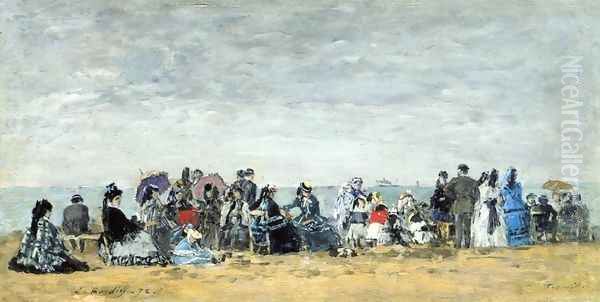
Working in his father's shop in Le Havre, Boudin was exposed to the world of art materials and, crucially, to artists themselves. The shop became a meeting place for painters working in the area. Boudin began framing pictures and interacting with artists who frequented the establishment. This environment nurtured his burgeoning interest in drawing and painting. Among the artists he encountered were figures associated with the Barbizon School and realism, such as Jean-François Millet, known for his depictions of peasant life, and Constant Troyon, celebrated for his animal and landscape paintings.
These established artists recognized Boudin's nascent talent and encouraged him to pursue painting seriously. By 1844, Boudin, together with a partner, opened his own stationery and framing business in Le Havre. His shop window often displayed works by artists he admired, including Millet, Troyon, and Thomas Couture. This venture further deepened his engagement with the local art scene. The encouragement he received, combined with his own growing passion, led him to make a life-altering decision. In 1846, at the age of 22, Eugène Boudin abandoned his commercial pursuits to dedicate himself entirely to becoming a painter.
Artistic Training and Development
Embarking on a full-time artistic career required formal training. Boudin initially studied art locally in Le Havre. His talent was recognized by the municipality, which granted him a scholarship in 1851, enabling him to move to Paris to further his education. This was a significant step, allowing him access to the heart of the French art world. In Paris, he briefly studied in the studio of the marine painter Eugène Isabey, whose work he admired. However, Boudin was largely self-directed in his learning.
He spent considerable time at the Louvre Museum, diligently copying the works of Old Masters, particularly Dutch and Flemish landscape painters known for their mastery of light and atmosphere. This practice honed his technical skills and deepened his understanding of composition and color. Yet, the confines of the studio and the act of copying ultimately felt limiting to him. His true classroom was the outdoors. Boudin began traveling extensively, seeking inspiration directly from nature.
His travels took him throughout Normandy and Brittany, regions whose coastlines offered endless subject matter. He also ventured further afield, visiting Belgium and the Netherlands in the mid-1850s. These trips exposed him to different landscapes and artistic traditions. A particularly formative encounter occurred during this period: his meeting with the Dutch painter Johan Barthold Jongkind. Jongkind, already known for his expressive, pre-Impressionist marine paintings created outdoors, became a crucial influence and friend. Jongkind strongly encouraged Boudin's inclination towards painting directly from nature, reinforcing the idea that capturing the immediate sensation of light and atmosphere was paramount.
The Birth of a Style: Painting Outdoors
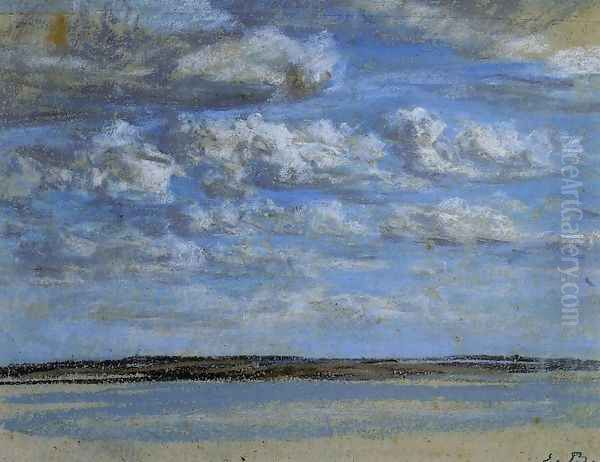
Eugène Boudin was among the vanguard of artists who systematically embraced en plein air painting. While painters before him, like those of the Barbizon School such as Jean-Baptiste-Camille Corot, had made outdoor sketches, Boudin took the practice further, often completing finished or near-finished works directly before the motif. He recognized that the fleeting effects of light, weather, and atmosphere could only be truly captured through immediate observation. Setting up his easel on beaches, harbor quays, and riverbanks, he worked quickly to record the transient moments of nature.
This approach was revolutionary at a time when landscape painting was still largely dominated by studio compositions based on sketches and memory. Boudin sought authenticity, aiming to convey the specific quality of light – the damp haze of a Norman morning, the bright sunshine on a summer beach, the dramatic cloud formations preceding a storm. His brushwork became looser and more visible, reflecting the speed required to capture these momentary effects. His palette, while often favoring subtle greys, blues, and earth tones, could also incorporate touches of brighter color to convey sunlight or reflections on water.
His dedication to capturing atmospheric truth earned him the admiration of fellow artists. Corot, a leading landscape painter of the older generation, famously praised Boudin, calling him the "King of Skies." This title aptly reflected Boudin's extraordinary ability to render the vast, ever-changing canopy above the sea and land. His skies are never mere backdrops; they are active participants in the scene, full of movement, light, and meteorological drama. Boudin meticulously noted the date, time, and weather conditions on many of his studies, underscoring his commitment to observational accuracy.
Normandy's Muse: Seascapes and Skies
The coastline of Normandy remained Boudin's most enduring source of inspiration throughout his career. The towns of Honfleur, Trouville, and Deauville, along with the broader Seine estuary and the English Channel coast, feature prominently in his oeuvre. He painted the bustling harbors filled with fishing boats and sailing ships, capturing the daily life of these maritime communities. Works like Festival in the Harbor of Honfleur (1858) showcase his early ability to handle complex scenes with lively detail and atmospheric coherence.
He was particularly drawn to the fashionable seaside resorts of Trouville and Deauville, which became popular destinations for Parisian society during the Second Empire. Boudin documented the elegant figures strolling along the beaches, their colorful attire contrasting with the sands and the sea. These beach scenes, while capturing a specific social milieu, are primarily studies of light and atmosphere. The human figures are often rendered with summary brushstrokes, integrated into the broader landscape rather than serving as individual portraits.
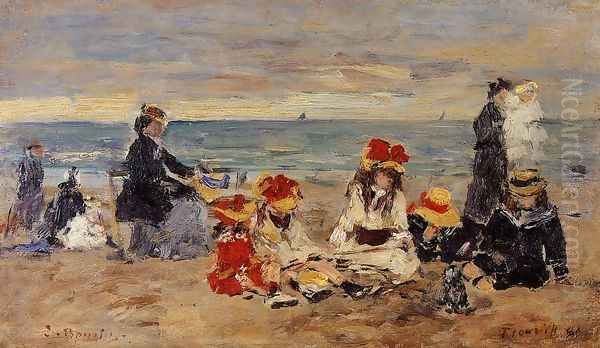
However, it is perhaps in his pure seascapes and sky studies that Boudin's mastery is most evident. He produced countless paintings and pastels focusing solely on the interplay between water and sky. Works like Seascape with Large Sky (circa 1860) demonstrate his skill in using pastels to achieve remarkable luminosity and textural effects. He captured the sea in all its moods – calm and reflective, choppy and windswept. Above all, his skies dominate, vast expanses filled with meticulously observed cloud formations, conveying the specific weather and time of day with uncanny accuracy. His dedication to these subjects cemented his reputation as the preeminent painter of the Norman coast.
Boudin and Monet: A Pivotal Mentorship
One of Eugène Boudin's most significant contributions to art history lies in his mentorship of the young Claude Monet. Around 1858, Boudin encountered Monet in Le Havre. At the time, Monet was gaining local recognition for his caricatures. Boudin, however, saw greater potential in the teenager. He recognized Monet's talent but urged him to move beyond caricature and embrace landscape painting, specifically painting outdoors.
Boudin invited Monet to join him on his painting excursions along the coast. He taught Monet how to truly see nature, how to observe the subtle shifts in light and color, and how to translate those observations onto canvas directly and spontaneously. Monet later recalled Boudin's crucial influence, stating, "It was as if a veil was torn from my eyes; I had understood, I grasped what painting could be... my destiny as a painter opened up before me." Boudin's insistence on painting en plein air and his focus on capturing immediate visual sensations were foundational lessons for Monet.
This mentorship laid the groundwork for Monet's development as a leading figure of Impressionism. Boudin's emphasis on light, atmosphere, and direct observation became core tenets of the Impressionist movement. While Boudin's own style remained perhaps more grounded in naturalistic observation than the fully developed Impressionism of Monet, his guidance was instrumental in setting Monet on the path that would revolutionize painting. Their friendship endured, and they exhibited together in the first Impressionist exhibition.
Engaging with the Art World: Salons and Impressionism
Boudin sought recognition within the established art structures of his time, primarily the official Paris Salon. He made his Salon debut in 1859 with Pilgrimage of Sainte-Anne-la-Palud. This work caught the attention of the influential poet and art critic Charles Baudelaire. In his review of the 1859 Salon, Baudelaire praised Boudin's pastel studies of skies, writing eloquently about their ability to capture the "prodigious magic of air and water." This critical notice helped to raise Boudin's profile.
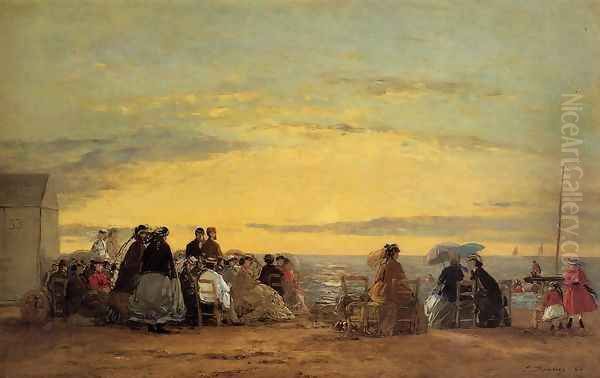
From 1861 onwards, Boudin became a regular exhibitor at the Salon, submitting landscapes and marine paintings. While his work was generally well-received by critics who appreciated his sincerity and observational skill, he did not achieve widespread fame or financial success easily. His life, particularly in the earlier years, was marked by financial struggles, sometimes forcing him to paint decorative works or copies to make ends meet. He gradually built a network of supporters and collectors, including the writer Alexandre Dumas and the Russian novelist Ivan Turgenev (Tourgueneff). The art dealer Pierre-Firmin Martin also played a role in promoting his work.
In 1874, Boudin was invited to participate in the first exhibition of the "Société Anonyme Coopérative des Artistes Peintres, Sculpteurs, Graveurs, etc.," held in the former studio of the photographer Nadar. This exhibition would become legendary as the First Impressionist Exhibition. Boudin exhibited alongside artists like Claude Monet, Camille Pissarro, Pierre-Auguste Renoir, Edgar Degas, Alfred Sisley, and Berthe Morisot. While Boudin shared their commitment to capturing modern life and the effects of light, his style was generally considered less radical than that of the core Impressionists. His participation, however, underscores his close ties to the group and his status as a respected elder figure and pioneer of the principles they championed. He did not participate in subsequent Impressionist group shows, preferring to continue exhibiting at the official Salon.
Recognition and Later Years
Despite early financial difficulties, Boudin's persistence and talent gradually earned him greater recognition and stability in his later career. His reputation as a master of marine painting grew steadily. He found dedicated patrons, such as Charles de Bériot, who amassed a significant collection of his works. His paintings began to sell more consistently, allowing him a more comfortable existence.
Official accolades eventually followed. In 1881, he received a third-class medal at the Paris Salon, followed by a second-class medal in 1883. A major honor came in 1889 when he was awarded a gold medal at the Exposition Universelle in Paris, a testament to his established position in the French art world. Perhaps the most significant official recognition was his appointment as a Chevalier of the Legion of Honour in 1892, France's highest order of merit.
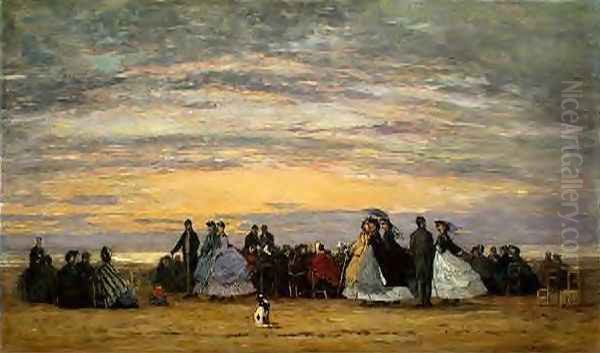
In his personal life, Boudin married Marie-Anne Guédès, a woman from Brittany, in 1863. She was eleven years his senior. They settled primarily in Paris but spent considerable time in Normandy and Brittany, where Boudin continued to find his primary inspiration. He maintained his rigorous practice of outdoor painting, traveling frequently along the coasts of France, and also making trips to Venice later in life, capturing the unique light and atmosphere of the Italian city. Boudin continued to paint prolifically until the end of his life. He passed away in Deauville, one of the seaside towns he had so often depicted, on August 8, 1898, at the age of 74.
Representative Works in Focus
Boudin's vast output includes thousands of paintings and pastels. Several works stand out as representative of his style and concerns. Festival in the Harbor of Honfleur (1858, National Gallery of Art, Washington D.C.) is an early masterpiece, depicting a bustling scene with numerous figures and boats under a luminous sky. It showcases his ability to organize complex compositions while maintaining atmospheric unity and capturing the specific light of his native Honfleur.
His numerous views of Trouville and Deauville capture the essence of these fashionable resorts. Trouville, the Port (1885) and Trouville at Low Tide (1878) exemplify his fascination with harbor scenes, depicting the array of masts and hulls against the backdrop of the town and sky, often focusing on the effects of tide and light. Another version, Trouville, the Port at Low Tide (1887, National Gallery of Art, Washington D.C.), further demonstrates his continued exploration of this theme. The beach scenes, such as Beach Scene at Trouville (various dates), capture the blend of nature and society, with elegantly dressed figures populating the sandy expanses under vast, expressive skies.
The pastel Seascape with Large Sky (circa 1860) highlights his mastery of this medium, used effectively to convey the softness and brilliance of cloud formations and the subtle gradations of light in the sky. Works titled simply Sky Study or Clouds attest to his almost scientific interest in meteorology and atmospheric effects. Across these works, common threads emerge: a commitment to observation, a sensitivity to light and atmosphere, and an unparalleled ability to render the sky in all its infinite variety.
Legacy and Influence
Eugène Boudin's legacy is multifaceted. He is undeniably one of the most important precursors of Impressionism. His unwavering commitment to en plein air painting, developed even before the movement coalesced, provided a crucial model for younger artists. His emphasis on capturing the fleeting moment, the specific effects of light and atmosphere, and the beauty of everyday modern landscapes directly anticipated the core concerns of the Impressionists. His mentorship of Claude Monet alone secures his place in art history as a catalyst for change.
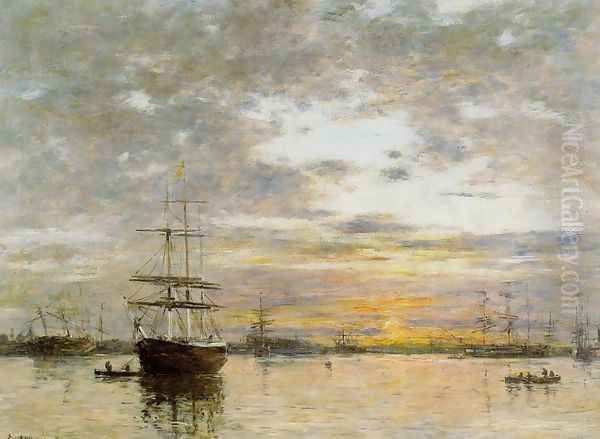
Beyond his role as a precursor, Boudin is celebrated as a master landscape and marine painter in his own right. His depictions of the Normandy coast are considered definitive, capturing the unique character of its harbors, beaches, and skies with unparalleled sensitivity. His "sky paintings" earned him the moniker "King of Skies" from Corot, and his ability to render clouds and atmospheric effects remains admired. He successfully bridged the gap between the naturalism of the Barbizon school, represented by artists like Millet and Corot, and the emerging modernism of Impressionism. He shared subject matter with contemporaries like Gustave Courbet, who also painted the Normandy coast, but Boudin's touch was generally lighter and more focused on atmospheric nuance.
His influence extended beyond Monet, contributing to a broader shift towards landscape painting based on direct observation. Artists who followed the Impressionists, such as Georges Seurat with his pointillist technique or even Vincent van Gogh in his expressive landscapes, built upon the foundations laid by Boudin and the Impressionists in terms of color and light. Today, Boudin's works are held in major museum collections worldwide, including the Musée d'Orsay in Paris, the National Gallery in London, the Metropolitan Museum of Art in New York, and the National Gallery of Art in Washington D.C. His paintings continue to be sought after by collectors, and his reputation as a subtle, sincere, and profoundly influential painter remains secure. The catalog raisonné compiled by Robert Schmit provides a comprehensive record of his prolific output.
Conclusion
Eugène Boudin, the humble son of a Honfleur pilot, rose to become a defining painter of the French coast and a crucial figure in the development of modern art. His intimate knowledge of the sea and sky, gained during his youth, translated into a lifelong artistic pursuit of capturing their ephemeral beauty. As a pioneer of en plein air painting, he championed direct observation and sensitivity to light, paving the way for Impressionism. His mentorship of Monet proved transformative for the younger artist and for the course of art history. Celebrated as the "King of Skies," Boudin left behind a luminous body of work that continues to enchant viewers with its atmospheric truth and quiet poetry, securing his place as a master of 19th-century French landscape painting.